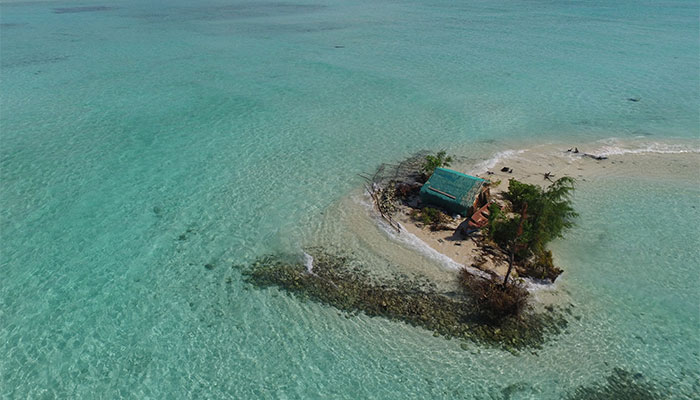Macquarie-Led Research Team Warns of Coastal Habitats in Peril
Seventeen thousand years ago you could walk from Germany to England, from Russia to America, from mainland Australia to Tasmania. Sea levels were about 120 metres lower than today. But, as the last Ice Age ended, the oceans rose quickly by one metre a century on average.
Vast swathes of coastal habitat were wiped out and recovery took thousands of years.
Rapid sea-level rise and coastal habitat retreat will happen again if warming levels rise above Paris Agreement targets, warns a global research team led by Macquarie University.
The researchers say that these mangroves, marshes, coral reefs and coral islands are essential to protect coastlines, trap carbon, nurture juvenile fish and help sustain millions of coastal residents.
In the paper, the authors, from 17 institutions in Australia, Singapore, Germany, USA, Hong Kong and the UK, report on how these coastal habitats retreated and adapted as the last Ice Age ended and how they are likely to cope with this century’s predicted sea-level rises.
“Coastal ecosystems exist where our oceans meet the land, including mangroves, coastal marshes and the fringes of sandy coral islands – the low-lying areas flooded and drained by tidal salt water,” said lead author, coastal wetlands specialist Professor Neil Saintilan from Sydney’s Macquarie University.
“Our research shows these coastal habitats can likely adapt to some degree of rising sea levels but will reach a tipping point beyond sea-level rises triggered by more than 1.5 to 2°C of global warming.
“Without mitigation, relative sea-level rises under current climate-change projections will exceed the capacity of coastal habitats such as mangroves and tidal marshes to adjust, leading to instability and profound changes to coastal ecosystems.”
Mangroves grow in the tropics, predominantly in Bangladesh, southeast Asia, northern Australia, equatorial Africa and low-latitude Americas. Smaller mangrove colonies can be found further south, such as at Sydney Olympic Park, and Towra Point in Botany Bay, which is listed as internationally significant under the Ramsar Convention.
Coastal marshes grow in intertidal zones further away from the equator, most common along the Atlantic shores of North America and Northern Europe. Australia has more than one million hectares of coastal marshes, most abundantly found in Northern Territory, Queensland and Western Australia, and the third highest area of mangroves in the world, behind Indonesia and Brazil.
“Mangroves and tidal marshes act as a buffer between the ocean and the land – they absorb the impact of wave action, prevent erosion and are crucial for biodiversity of fisheries and coastal plants,” said Professor Saintilan.
“They also act as a major sink for carbon, so-called blue carbon, through absorbing carbon dioxide from the atmosphere.”
Mangroves and tidal marshes have some in-built capacity to adapt to rising seas. They do so by accumulating sediment and moving slowly inland.
“Mangroves and other tidal plants have to get oxygen down to their roots to survive, and so that phase of the tide when water drains right out is really important,” said Professor Saintilan.
“When the plants become water-logged due to higher sea levels, they start to flounder. At Sydney Olympic Park, we’ve seen whole patches of mangroves die when water can’t drain out properly.
“This sort of death would be devastating for many natural mangrove forests across Asia which are restricted in their capacity to retreat from rising seas due to land development and human habitation.”
Reefs protect coral islands by forming a coastal ecosystem that protects the inner, liveable land from the powerful impacts of the open sea.
“Beyond 1.5 to 2°C of global warming, you’ll start to see these islands disappear when the waves overtop the coral reefs that protect them,” said co-author Associate Professor Simon Albert, from The University of Queensland.
“In the short term, coastal ecosystems can play a vital role in helping us humans mitigate climate change by taking carbon dioxide out of the atmosphere and offering protection against ocean storms – but we’ve got to help them as well.”
Co-author Torbjörn Törnqvist, Vokes Geology Professor in the Department of Earth and Environmental Sciences at Tulane University in New Orleans, Louisiana, said subsidence – a gradual sinking of land – exacerbates the exposure of ecosystems to rising sea levels.
“The most vulnerable coastal regions within the USA are in Louisiana and Texas. These states have the highest subsidence rates, partly due to the pumping of oil, gas and groundwater from the subsurface,” Professor Törnqvist said.
Professor Saintilan adds: “In Indonesian coastal cities such as Jakarta and Semarang they pump out a lot of groundwater for their populations which causes the coastal plain to sink.”
The scientists analysed the conversion of coastal ecosystems to open water and reviewed how they adapted to sea-level rise following the last Ice Age.
“The study of past sea levels is one of the most important fields of climate-science study and is the basis for sea-level projections,” said co-author Professor Benjamin Horton, Director of the Earth Observatory of Singapore at Nanyang Technological University.
The Paris Agreement’s central aim is to strengthen the global response to the threat of climate change by keeping global-temperature rise this century well below 2°C above pre-industrial levels, and to pursue efforts to limit the temperature increase even further to 1.5°C.

